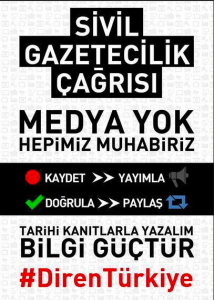This post was written by Michelle McCloskey for WITNESS.
As the #OccupyGezi protests have surged, Turkish mainstream media has foundered, failing to cover the anti-government demonstrations for fear of retribution. Citizen journalists–“sivil gazeteci,” in Turkish–have stepped up to fill the role so that the Turkish people and the world can see what's happening in the country.
Though a successful democracy by many standards, Turkey has more journalists in jail than any other country. Through financial penalties and legal intimidation, Prime Minister Recep Tayyip Erdoğan and his Justice and Development Party (AKP) have ensured that Turkish news networks either have a pro-AKP slant or censure themselves entirely. On the evening of June 1, 2013, while CNN Turk was showing a documentary on penguins, protesters gathered momentum throughout the country, even in pro-AKP Konya.
Turkey's English-language newspapers reflected a very different report than the Turkish versions. The Turkish people’s loss of faith in accurate reporting in Turkish media was bolstered by the reports shared on social media sites such as Twitter, Facebook, Tumblr, and Reddit, showing in real-time that people from all facets of Turkish society were taking a stand against the deterioration of their civil rights at the expense of increasingly pro-Islamist or neoliberal policies.

Translation:
Call for Citizen journalists
No mainstream media
We are all correspondents
Save >> Publish
Verify >> Share
Let's make historical evidence
Knowledge is Power
#ResistTurkey
By the fifth day of protests, Erdoğan went on national television, calling the protesters “arm-in-arm with terrorists” and telling the protesters, “If you bring 100,000, I’ll bring out a million”. In response, “Street Reports”, which appears to be a media/activist collective that interviews people on the street for their opinions on subjects from politics to culture, spoke with the protesters themselves, showing students, mothers, civil servants, the elderly, women in headscarves as well as women without, and even members from varying political parties and soccer clubs, all joined together in the protests.
Livestreams of the protests were made available online so that people could witness the brutality of the police shooting tear gas directly at protesters, into homes, as well as firing water cannons at close-range (Warning: Graphic video).
Citizen journalists are sharing these videos and photos in both English and Turkish in an effort to provide a more in-depth understanding of what is happening in Turkey right now, but more importantly, to allow citizens in Turkey to see what is occurring in their own country.
Here are some resources you can use to follow the movement:
Twitter Accounts
- Emre Kizilkaya (Chief Editor of Foreign News Service at Hürriyet, Turkey's largest newspaper)
- Basak Gok (activist in Izmir)
- Pinar Saglam (activist in Ankara)
- Erencan Ozkan (activist in Istanbul)
- 140 Journos (free press organization in Turkey)
- International Law News (based in Istanbul)
- Gezi Parki Haber (Gezi Park News)
Facebook Groups
- Diren Gezi Parki -Turkish (Resist(ance) Gezi Park) [Turkish]
- Occupy Gezi [English]
Websites
- Crowdvoice coverage of Istanbul protests through photos/videos/links/tweets
- A multimedia timeline of the protests, with suggestions on how to advocate to Turkish media to cover the protests.
WITNESS Guide to Filming Protests [English]
- Full playlist
- Part 1: Prepare to Film
- Part 2: Choose the Right Tools
- Part 3: Work as a Team
- Part 4: Filming Tips
- Part 5: Conducting Interviews
Michelle McCloskey spent her formative childhood years in Istanbul and majored in Turkish Language and Literature; she is deeply committed to to the future and the culture of the country. She recently created Linguaphile, a nonprofit devoted to critical, endangered, dying, and diaspora languages [website under development].




4 comments
Translation is wrong.
“Tarihi kanıtlarla yazalım.” doesn’t mean “Let’s make historical evidence”. It means “Let’s write history with evidence.”